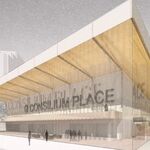I think that adma is quite astute to note that the Chinatown Centre and Dragon City are disproportionately feeling the crunch of declining business. They suffer from a couple of problems that distinguish them from the other businesses in the neighbourhood.
Problem 1: Modeled as malls, these spaces are disconnected from the circulation of the street and require the shopper to in effect leave the city to gain entrance. This is a leap of faith that the average passer-by or infrequent shopper might be unwilling to take; the street, with all its mess and bustle, is familiarly public. There is more than enough out there to hold the attention of the casual shopper. These spaces are internally coherent (at least theoretically) destinations, not part of the logic of the street corridor. As places to go TO as opposed to THROUGH they are especially hard-pressed to compete with their suburban counterparts who can serve vast catchment areas with their parking lots.
Problem 2: They were conceived as a step in the "upscaling" of Chinatown that failed to predict the changing geography of the Chinese community in Toronto. They were built on the assumption that Chinatown would remain THE Chinatown, that the ever-more prosperous immigrants of the mid-20th century HK/Taiwan wave would still consider Spadina/Dundas to be the hub of their commercial and cultural lives. This ultimately proved wrong. They moved north and founded new cultural/commercial districts nearer to their new homes to cater to their more upscale shopping habits. The bulk of the 1990s HK wave moved to these communities as well. They were much more affluent than their predecessors (and their mainland contemporaries), and better equipped from the start to afford the north american luxuries that the earlier HK wave had to build up to (big house, big lawn, big car, big mall). These people had no connection to the Spadina Chinatown and little reason to feel an allegiance to it. Quite reasonably they invested in the community closer to them, making it the best concentration of services for their particular demographic.
Chinatown was again left to the locals, who are still predominantly poor and working-class new immigrants - those mainland contemporaries I previously mentioned and the growing vietnamese demographic. I think to some extent the "improvement" of Chinatown was a demographic blip where the chinese commercial dispersal had not caught up with the community's residential dispersal across the GTA. For a while, the Spadina Chinatown was THE Chinatown, but this situation was unsustainable as other concentrations of Chinese immigrants created their own critical mass. Much of the declining businesses, including the two main malls and the glut of nearly empty restaurants are leftovers from those days when Spadina had an unchallenged regional pull.
I would argue that Chinatown is returning to its old role as an affordable and supportive neighbourhood for new immigrants after an anomolous phase as the sole regional draw for a dispersed ethnic community. The food markets and banks and pastry shops are bustling and the streets are packed with locals on their day-to-day business. Things are changing now as always, and will likely change more as CityPlace establishes itself with its more upmarket and young Asian demographic and the new BIA makes its mark, but any claims of Chinatown's death, as a commercial district or as an ethnic hub, to me seem highly exaggerated.




